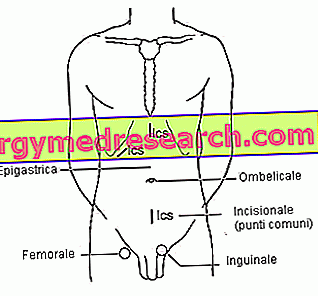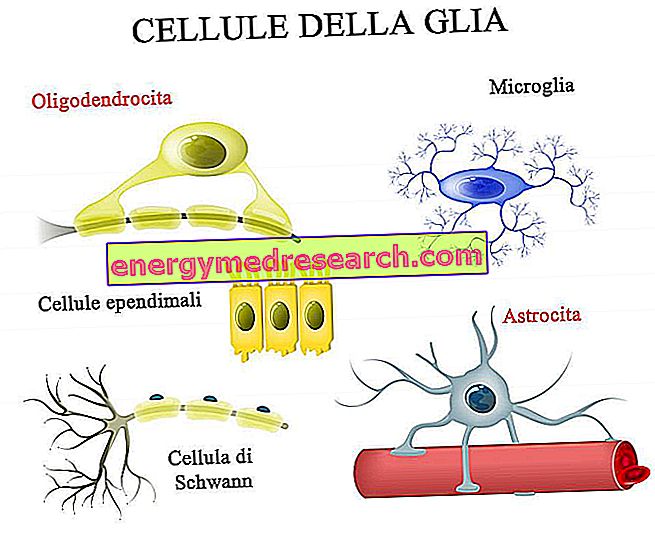Definition
The abdominal hernia is the escape of a bowel - or a part of it - from the abdominal cavity where it is normally contained.
The herniation makes its way through a preformed orifice or an area of weakness of the cladding wall.

Abdominal hernias are called external because the viscera, slipping between the different structures that form the abdominal wall, push themselves outwards becoming evident. In this sense, abdominal hernias differ from internal herniations (eg herniated discs, diaphragmatic hernias, cervical hernias), where the displacement of the bowel occurs inside the body, therefore from the outside no protuberance is noted.
It is estimated that abdominal hernias are the most frequent herniations of all, affecting 5-6% of the entire global population.
Classification and causes
The term "abdominal hernia" is rather generic since in this category fall numerous forms of herniation. The abdominal hernia can be congenital or acquired : in the first group include umbilical, inguinal and criptorchide hernias, while weakness hernias (eg crural hernia) and exertional hernias are acquired forms.
All acquired abdominal hernias are united by some predisposing factors:
- Abdominal anatomy changes
- Ascites
- Weight loss
- Severe breathing difficulties
- Multiple pregnancies
- Traumatic lesions in the abdominal area (eg caused by surgery)
- Obesity / overweight
- Constipation
Congenital abdominal hernias are generally an expression of an abdominal wall development arrest during the embryonic period.
Common features
To learn more: Symptoms Abdominal hernia
Despite the numerous forms of abdominal herniation, it is possible to identify three constant elements in all the different variants:
- Hernial door: it is the gap from which the bowel comes out. The hernial gate can be constituted by the umbilical ring (umbilical hernia), by the inguinal canal (inguinal hernia) or by any area in which the muscles have a weaker area or a stretch mark.
- Sack: it is an extroflexed loop of peritoneum (serous membrane that acts as a lining of the abdominal organs) in which the herniated bowel is positioned. When the phenomenon occurs since birth, we speak of a congenital abdominal hernia.
- Contents of the abdominal hernia: it is the organ or portion of the bowel that has moved from its original location.
Inguinal abdominal hernia
The inguinal hernia is the most widespread among abdominal hernias, of which it is about 80% of the cases. It occurs mainly in subjects between the ages of 20 and 60; however, there are also peaks among the elderly and children. This variant of abdominal hernia mainly affects males: it is estimated that men are affected 7 to 10 times more than women.
The congenital inguinal hernia is generally manifested during early infancy due to a lack of occlusion of the vaginal peritoneum duct, a canaliculus present in the fetal phase used for the migration of the testicle from its place of origin (lumbar site, near the kidney downwards ) to the scrotum.
The acquired inguinal hernia is an expression of a progressive weakening of the abdominal muscles near the groin: the collapse of the muscular scaffold is favored by overweight, age, type of heavy work activity, pregnancy, excessive effort or metabolic pathologies (collagen anomalies ).
The inguinal hernia may or may not be painful: the extent of pain increases if the hernia compresses an area rich in nerve endings.
In severe cases, the inguinal hernia degenerates into a herniated or incarcerated hernia, with the risk of death from syncope, shock and gangrene. Choking of the hernia occurs when the herniated bowel is literally strangled by the ligamentous and muscular structures of the abdominal wall or by a stenosis (narrowing) of the hernial gate. This phenomenon causes a stagnation of intestinal material and prevents the blood from reaching the other neighboring sites.
This form of abdominal hernia must be treated surgically.
It is not uncommon for the inguinal hernia to be associated with a failed descent of the testicle into the scrotal bursa: this pathological condition is called hernia-criptorchidia.
Umbilical abdominal hernia
Umbilical hernia is an abdominal herniation that develops at the umbilical scar. Umbilical hernia is typical of children, but can also affect adults and the elderly.
More often, in the child the umbilical hernia is the result of a defect in the closure of the abdominal wall after the fall of the umbilical cord. However, some small patients are affected by this abdominal herniation due to disorders of collagen metabolism and polysaccharides, congenital hypothyroidism, Down syndrome or fetal hydantoin syndrome (a drug used to treat epilepsy).
In adults, umbilical hernia is caused by an increase in intra-abdominal pressure, in turn induced by ascites, cirrhosis, pregnancy, extreme strain or neoplasms.
In the newborn, the umbilical hernia tends to regress spontaneously over a few months, without necessarily intervening with surgery. Unlike in the adult, umbilical hernia is generally subjected to surgery to minimize the risk of extremely dangerous complications (incarcerated hernia and strangled hernia).
Crural abdominal hernia
Also known as a femoral artery, the crural hernia constitutes 2-5% of all abdominal hernias.
To understand...
The crural region is located lower than the inguinal fold, in an extremely weak anatomical site. The crural region is a space delimited by the femoral arch, the horizontal branch of the pubis and the femoral artery and vein.
The crural hernia has a marked predilection for the female sex and, generally, the first symptoms appear after the age of 30. This form of abdominal hernia is a consequence of an excessive weakening of the ileo-pubic fascia, in turn due to pregnancy or extreme physical efforts.
Compared to the inguinal groin, crural hernia tends to degenerate more easily in a herniated or incarcerated hernia. Herniation can sometimes be asymptomatic, but in an upright position it can cause pain in the thigh root. In most cases, pain - when present - is not accentuated by coughing or sneezing.
Also in this case, the only solution for the treatment of crural hernia is surgery: during the operation the hernial sac is eliminated and the damage is repaired at the level of the abdominal wall.



